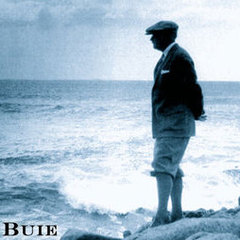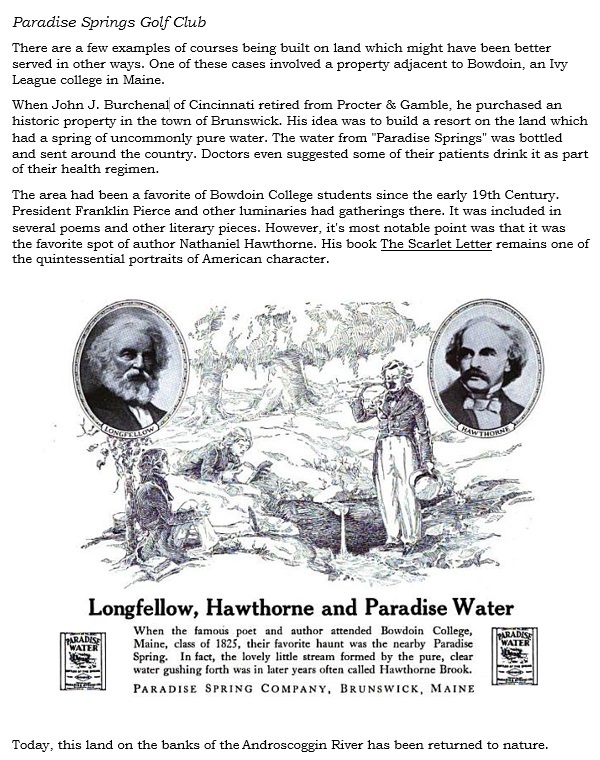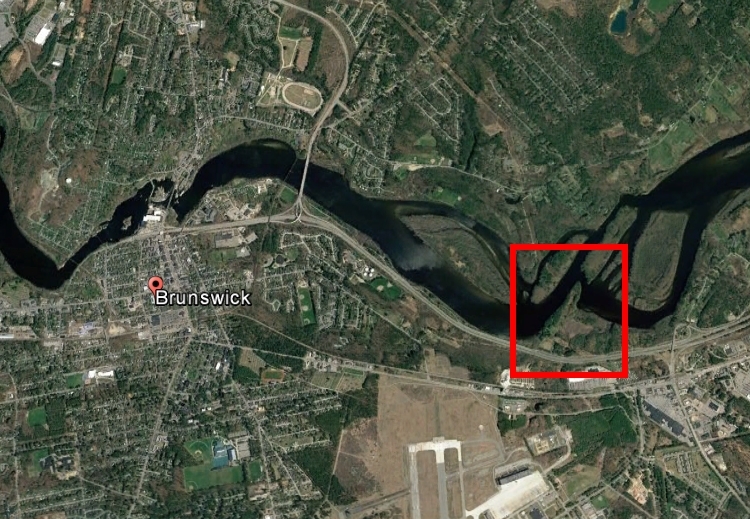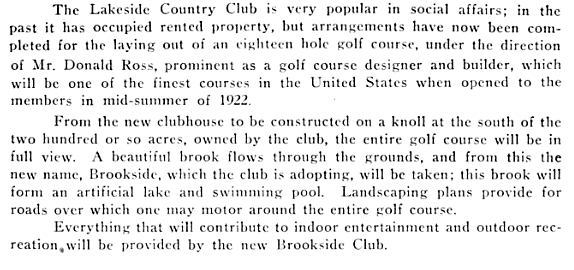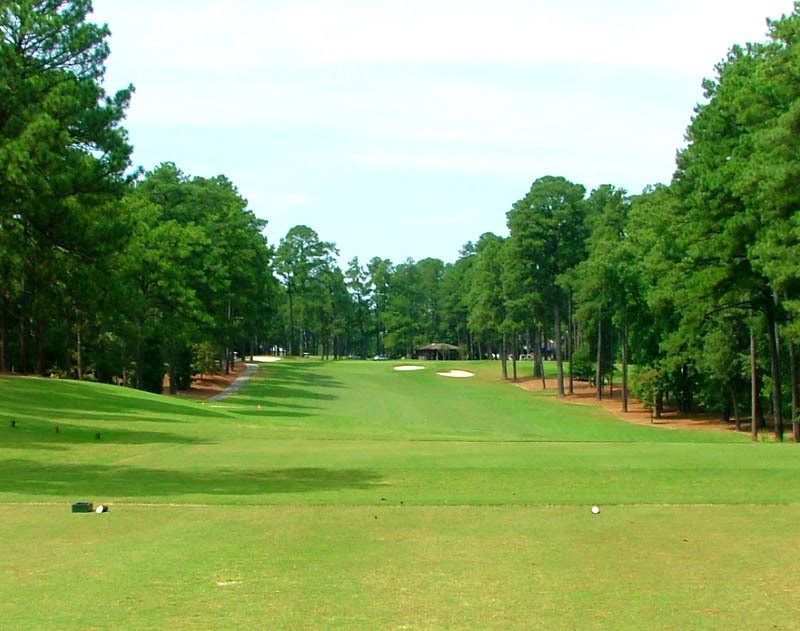-
Posts
10 -
Joined
-
Last visited
About Chris Buie

Personal Information
-
Your Location
Pinehurst, NC
Your Golf Game
- Index: 7
- Plays: Righty
Recent Profile Visitors
512 profile views
Chris Buie's Achievements
-
Being so prolific leads to a number of interesting situations. In this case, he created so many courses that some had the same name! He worked on two separate courses named Essex, as well! Thank you for catching that about the club in Solon, OH. I don't have much information on it but would certainly like to know more. It appears to have been a very fine course that was almost shut down but has be rescued. Is that correct? Also, it was over 6,500 yards in 1926. That means it was pretty muscular for the time and would hold up today quite well. I'll look into it and chime back in if I find more information on it. Thanks much again for pointing this out. Good work!
- 32 replies
-
- donald ross
- q&a
-
(and 1 more)
Tagged with:
-
Chris, I found your reproduction of the Donald Ross quote about American golf becoming almost entirely "aerial" absolutely delicious! The example I use in the book is Oakland Hills. The image comparison below says it all. NE Ohio is underrated for golf courses. There are several first rate courses there. I did a bit of digging this morning. Here's a quote regarding Mill Creek The park commissioners retained the services of Donald Ross, and the eighteen-hole North Course opened for play on July 31, 1928...Frank Hughes served as superintendent of construction under Ross, and later became park superintendent. He assisted in the development of the third nine holes, which opened on July 4, 1932...The final nine holes were completed by Ross in August of 1937. Tufts Archive info here: http://givenmemoriallibrary.net/vex/vex1/3645B7F1-E2C9-43D8-B2B9-242921656232.htm ... Hawthorne Valley Tufts info here: http://givenmemoriallibrary.net/vex/vex1/2AA1D15B-0F66-44D2-8BF9-778441521978.htm ... Here's a Ross quote specifically about Manakiki: In one respect Manakiki is unique. In almost every golf course, no matter how modern or expensively constructed it may be there are usually two or three of the holes that resemble one another. That is because the architect must do what he can with the topography presented. Ordinarily, he can't help but make some of the holes similar in design. But not at Manakiki. Here, every hole is different! As you go around the course, you never have the idea of sameness from any tee. That is, I believe, one of the most interesting features of this very splendid course.
- 32 replies
-
- 1
-

-
- donald ross
- q&a
-
(and 1 more)
Tagged with:
-
I have not gotten to Penobscot yet but I would certainly love to! Since you're in Maine, I'll show you an interesting bit that I was going to put in the book but edited out. You can see it in the images below. It's always interesting to me that, for decades, people can be right beside something remarkable and be completely oblivious of it. [The course drawing is from the Tufts Archives] Since we have Buckeye's on here, I've got an outtake for them too.
- 32 replies
-
- donald ross
- q&a
-
(and 1 more)
Tagged with:
-
Did Donald Ross every visit the location for Brookside Country Club in Canton, Ohio when it was being designed and/or built? To tell you whether or not Ross visited the Brookside property I'd have to do some digging. One of the best places to dig is here: http://fultonhistory.com/Fulton.html Make sure you put your inquiry in quotes. Most states have historical societies - many cities/towns do as well. They are great places to look. Here's a bit of info from the website: "Brookside Country Club ... originally took form as "Lakeside Country Club" in the last decade of the nineteenth century and in 1903, the members of "Lakeside Country Club" bought a casino and began reconstructing a 9-hole golf course located at Myers Lake in Canton, Ohio. In 1917, a move to acquire more land for an additional nine holes began and the search ended in 1920 at the present location. A year later, the famous golf course architect, Donald Ross, designed and built 18 holes of golf." And here is an interesting bit from a book called: 1921 Canton The City of Diversified Industries:
- 32 replies
-
- donald ross
- q&a
-
(and 1 more)
Tagged with:
-
If Donald Ross didn't visit the site of a golf course when asked to design it, what process did he use to design the golf courses? Did he required any sort of geographical information, like a survey? Here's an excerpt from a letter he wrote to Ponkapoag: "I will require a general plan of the property on a scale of one inch equals one hundred feet and contours at five foot intervals to be supplied by the Commonwealth of Massachusetts. After the course is laid out I will submit a general plan of the whole layout and also individual plans and specifications for each hole. Mr. Walter B. Hatch, my Associate...expects to call on you..." In the case of Ponkapoag, he did visit. However, the letter gives you some sense of how part of that process worked. ...................................................... How would you describe his philosophy when it came to designing a golf course? Ah, one could write an entire book on that alone. There's a large chapter on that in the Ross book (I did another book on how they transformed the barren wasteland of Pinehurst into a dreamworld previously: amazon.com/author/chrisbuie) He tried to incorporate all the natural features of the land. He tried to accommodate a wide variety of playing levels. He wanted thinking/strategy to be part of the experience. There are many, many different parts to how he approached design. Basically, he tried to make his designs as invigorating and intriguing and enjoyable as he could. ...................................................... Did he actually visit the Lucerne area to see the course or was this a "postcard" design? And are there very many Donald Ross 9 hole courses remaining? I don't think there are an abundance of 9 hole courses. In the appendix of my book there is a complete list (as we know it at this time) of all his courses. One of the items noted is how many holes he designed at each course. Regarding Lucerne, have a look here and tell me what you think and we'll discuss further: http://givenmemoriallibrary.net/vex/vex1/67EEF659-E134-4E4C-8C8E-397028601766.htm That is from the Tufts Archives in Pinehurst, by the way. It is an organization absolutely worth supporting. http://giventufts.org/tufts-archives You can find information on many of the individual courses here: http://givenmemoriallibrary.net/vex/vex1/toc.htm
- 32 replies
-
- donald ross
- q&a
-
(and 1 more)
Tagged with:
-
- 32 replies
-
- donald ross
- q&a
-
(and 1 more)
Tagged with:
-
What would Donald Ross think of the lob wedge? He would not like it. He did not like Sarazen's breakthrough with the sand wedge. Basically, he thought if the clubs were doing the work instead of the golfer then he didn't look kindly upon that. I have an article that specifically addresses that. I'll see if I can find it. What features of modern golf course architecture would Donald Ross find most alarming? In America the game is almost entirely aerial. He would be extremely upset to see the loss of the ground game - especially on his own courses. Watching the shot bump and run was a big part of the fun and the design. Taking that away from the game is unfortunate. Did he have much to do with the evolution of the golf course at Royal Dornoch? Very little. It's said he made a couple of suggestions when he returned later in life. I'm not sure if they were employed or not. I've heard different things. Dornoch was mainly a combination of Old Tom and John Sutherland. Sutherland tinkered with the course for at least half of a century so it's his course as much as anyones. When other golfers talk about his courses, I've heard you either Love them or Hate them. Is this a fair evaluation of his style? I actually haven't heard that opinion before. And, as you can imagine, I've heard a lot! I don't think he or his work are polarizing. I know people who prefer other designers and some think some of his courses are a bit bland (now). But I don't think I've ever heard of anyone hating his courses. Well, if hundreds of thousands look at your work there's going to be a few with unusual opinions. Also, I've heard his courses are mainly about the greens and the short game. I recall they truly tested them both. Greens and short game were certainly top of his list. But he was thoroughly involved in the rest of it as well. He was very much into angles off the tee, into the greens. It's amusing to watch pros aim for the flag with their approach shots on Pinehurst No. 2. There are places you do not want to miss and going at the flag, they can end up in some nasty places. If you don't think your way around that course you're in for a looong day. Not considering the best place to miss it is a big mistake. I usually tell first timers just to aim for the middle of the green - not at the flag. So, the green complexes were more intricate than most of the tee shots areas. But there was plenty of thought in them too. What stands out most about DR courses in your opinion, Chris? They accommodate wide varieties of playing capability. That is, a pretty high handicapper and the ace can play the same course and have a good time. Once experienced, he liked to design a course within a course. A way for the not so talented to get around ok, while at the same time if the ace was trying to score then he'd have to challenge some hazards. I think it was a big mistake when others made courses with only one way to play them and making them so difficult that people on in years couldn't really handle them. So, designing with both in mind was brilliant and kept things fun for everyone - or most everyone! I'll be back with more responses soon.
- 32 replies
-
- donald ross
- q&a
-
(and 1 more)
Tagged with:
-
Chris Buie changed their profile photo
-
How many courses - or a percentage maybe - did he design without ever really stepping foot on the property? It has been estimated that he did not visit approximately 1/4 of the courses he designed. Golf course architects are often famous for creating a certain type of hole or style of play - the Redan green, the penal style of play, etc. What is Donald Ross's lasting legacy in this narrow context? I would say high point to high point. That referrs to the terrain. There were a lot of par-3's like that, but also some other holes, as well. It was done for drainage but also made for good golfing. Here's the 5th and the 10th holes of Pinehurst No. 1 - both high point to high point: Donald Ross trained and worked with Dan Maples' grandfather, and Dan Maples has made a bit of a name for himself in the Pinehurst area as well. What other architects can trace a very direct line to Donald Ross? That's a very good question. It could be answered any number of ways. I'm not sure the design style worked sort of like the secret recipe of an Italian restaurant where only those privy were able to make a comparable sauce. Ellis Maples was Ross's primary protege as far as design goes. And he had his own style, as has Dan Maples. What Ross did is available to be studied. There are some who have studied Ross intently and have an impressive knowledge of how he went about things. When you put together knowledge and talent then you will get brilliant work. So, while there may be a certain degree of information which can be learned from being within a family or organization, it does not appear there is a direct line which carries the original work on. It may carry a measure of it but other factors seem to be more important. This is all to say that someone who knows Ross thoroughly and is talented will be able to carry on the style as well as anyone. That's my take on it at the moment. If I thought about it more I might answer a bit differently. What would surprise golfers to know about Donald Ross as a man? I've read he was very religious without being showy about it. Did he have any other hobbies? He played golf well, but how'd he spend his free time? Did he have any? He didn't have much free time but he did have some other hobbies. He rode horses and he was very keen on his rose garden. He really loved dogs too. He did not like it when a person could only talk about golf. What was Donald Ross's biggest regret? A course that didn't live up to its potential, a site he didn't get to develop… what? Hmm, that's a good question. Any answer would only be speculation. As you know he was extraordinarily realized. I doubt there was much he wanted to do golf wise he hadn't already done. He was properly angry about not winning the 1910 British Open at St. Andrews. He was winning in the 3rd round at one point. He had a stellar day...and they threw all the scores for that day out! (Because of an intense storm). I would guess he was sorry he didn't get to spend more time with his family in Scotland. He did what he wanted to do and he would have preferred to build the game in America as he did to a less eventful life. There was no way he could do both. But he probably missed the family and friends in Dornoch. What did you learn about Donald Ross that most surprised you in researching this book? He was extraordinarily principled. I knew he was an upright citizen but he just did not like to do things the wrong way. So, he made himself do things as he thought the proper way was. A bit of an odd question… Donald Ross supposedly designed the Delray Beach Golf Club's front nine (or back nine?). Do you have information on whether he visited the site, or was this another "postcard" type design? He did a design for Delray Beach. It would be a mistake to be dismissive about the ones he did from a topo. He knew what he was doing and he wasn't going to have his name on something that was not up to par. Sure the ones he did not visit could have been better. The places could have had him visit but usually they did not have the money. They understood what they were getting and they were sure that the golfing would at a minimum be adequate. The design below looks pretty darn good, does it not? I'll answer as many questions as I can when I get the chance. I'm happy to!
- 32 replies
-
- donald ross
- q&a
-
(and 1 more)
Tagged with:
-
It was great fun to research Mr. Ross's odyssey. The book turns up quite a few new items. I have files for many courses but not all of them. When I get a chance I will give you some pointers in looking up clubs you are interested in. I didn't see anything notable in my files about Miami Shores or Delray Beach - although the drawing of DB is terrific. However, I did have a file regarding Chautauqua. It looks like he did visit there. The article is attached, I think. I will be back answering more questions soon! Thanks
- 32 replies
-
- donald ross
- q&a
-
(and 1 more)
Tagged with:
-
Hello, it is great to join The Sand Trap! Apologies for not getting to your questions earlier. Let's see... Is there a list of other Ross courses around the country that can be played by normal public golfers? Dave, thanks for the question. My friend Paul Dunn just republished his book called: Great Donald Ross Golf Courses Everyone Can Play I thoroughly enjoyed the book and it is specifically geared for courses open to everyone. Also, in the back of my book is the current list of all known Ross courses. One of the notations is whether they are public, private, semi-private, etc. https://classicsofgolf.com/product/life-times-donald-ross/ I've read that Mr Buie enjoys the Southern Pines GC. Is there any chance that the "lost" 9 holes there will ever be restored? Yes, I certainly enjoy SPGC. I've been playing it for about 40 years and still have not gotten tired of it. The 'lost 9' is the course I learned to play on. It was $22...for the summer. It's good to have boys out there running around all day - less mischief and mayhem. Yes, it is possible they could re-open that course. I don't think they are going to put buildings or anything else on there. I would imagine it would return at some point in the not too terribly distant future. Right now it is just overgrown. But they do mow it regularly so...we'll see!
- 32 replies
-
- 1
-

-
- donald ross
- q&a
-
(and 1 more)
Tagged with:


